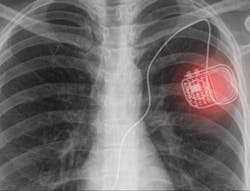Active photonic wireless system could power medical implants
Most implantable medical devices such as pacemakers require a constant source of energy to operate, which has limitations. For example, batteries have a finite lifespan and once the battery power gets exhausted, there is no other option but to perform invasive surgery to replace the battery, which poses a risk of surgical complications such as bruising, infections, and other adverse events.
Recognizing this, a team of researchers at the Gwangju Institute of Science and Technology (GIST; Gwangju, South Korea), led by Professor Jongho Lee, has developed a strategy to recharge the internal battery of medical implant devices without invasive surgery or risky penetrative procedures.
“One of the greatest demands in biomedical electronic implants is to provide a sustainable electrical power for extended healthy life without battery replacement surgeries,” says Lee. Although this is a tricky concept, Lee believes that the answer lies in the “translucency” of living tissue.
When, for example, a hand is held up to a powerful light, it can be seen that the edges of the hand glow as the light passes through the skin. Taking inspiration from this, Lee and his team developed what they call an “active photonic power transfer” method, which can generate electrical power in the body. This novel system consists of two parts: a skin-attachable micro-LED source patch, which can generate photons that would penetrate through the tissues, and a photovoltaic device integrated into a medical implant, which can capture the photons and generate electrical energy. This system provides a sustainable way of supplying the medical implant device with enough power to avoid any high-risk replacement methods.
“Currently, a lack of a reliable source of power limits the functionality and performance of implant devices. If we can secure enough electrical power in our body, new types of medical implants with diverse functions and high performance can be developed,” says Lee.
When the scientists tested this power system in mice, they found that this wireless power transfer system is easy to use, regardless of weather, clothes, indoor or outdoor conditions, etc. The light photons emitted from the source patch penetrated live tissues in mice and recharged the device in a wireless and convenient manner.
“These results enable the long-term use of currently available implants, in addition to accelerating emerging types of electrical implants that require higher power to provide diverse, convenient diagnostic and therapeutic functions in human bodies,” says Lee, who is already looking forward to furthering the team's experiments.
Full details of the work appear in the Proceedings of the National Academy of Sciences of the United States of America.
